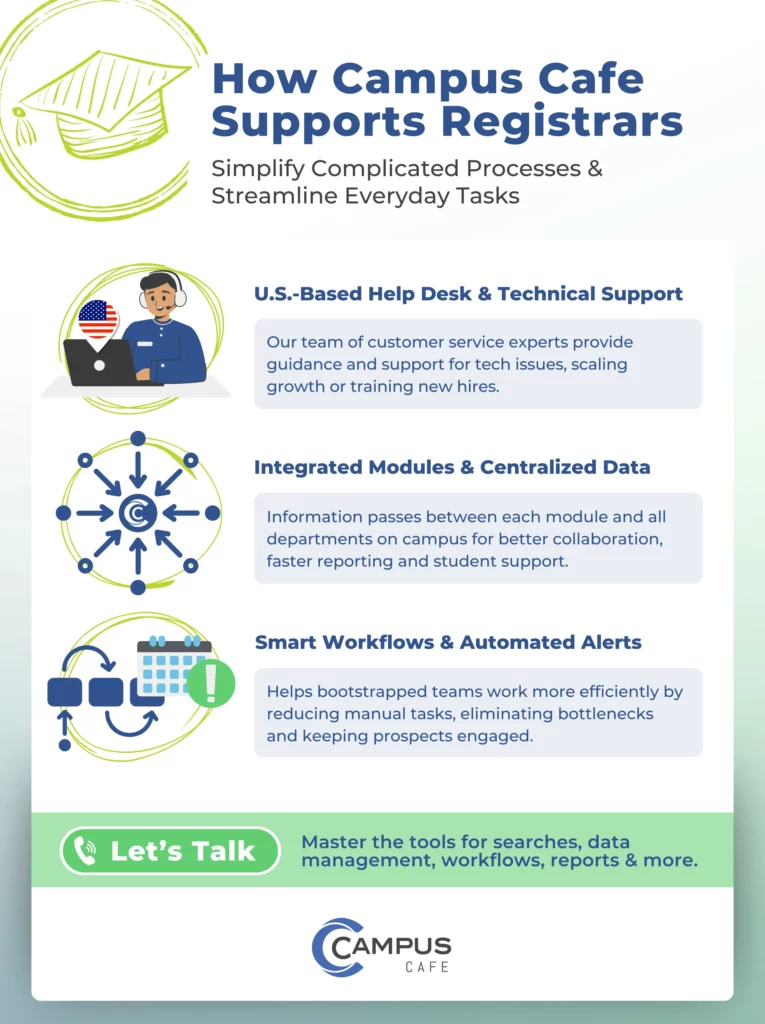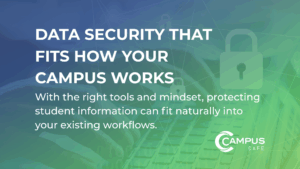
Inside every college, university, and career school is a critical nerve center leading data and operations: the registrar’s office.
The registrar’s team is the gatekeeper of student and institutional data, managing academic records, course registration and student information.
Registrars have a hand in nearly every aspect of campus life. The vast majority (86%) cite academic records as their most important duty, followed by policy work (61%), data management (38%) and curriculum work (35%) according to a survey of registrars by the American Association of Collegiate Registrars and Admissions Officers.
If registrars are bogged down with manual tasks like tracking data on spreadsheets or working in a legacy SIS with wrong information, basic activities can become unnecessarily time-consuming.
A cloud-based student information system can help the office run more efficiently: Information is easier to find, data can be processed faster and more accurately, and it drives strategic decision-making.
This post will discuss how technology is helping registrars manage student data more efficiently while supporting today’s students. Specifically, we’ll cover the following topics:
Overcoming Top Challenges Facing Today’s Registrars
From dealing with administrative complexities to navigating technology issues and regulatory guidelines, the registrar’s success is predicated on having access to reliable data.
Manual methods of maintaining student information and repetitive tasks that could instead be automated mean hours lost on the phone and responding to email inquiries.
A student information system (SIS) helps registrars and student support teams streamline academic records management and process student information faster. Below is a short list of some of the registrar’s top challenges and how an SIS can be used to overcome them.

1. Balancing Enrollment Management and Student Retention
The registrar is responsible for ensuring adequate course offerings, optimizing class sizes and implementing strategies to support student success, which are often competing priorities.
Challenge: Balancing enrollment goals with student retention efforts and academic standards.
Solution: An SIS provides tools like degree audits, a plan of study feature and reporting capabilities to help registrars fulfill course offerings, monitor enrollment trends and identify at-risk students.
Outcome: Data-driven decision-making and retention strategies improve graduation rates and institutional goals.
2. Time-Consuming Transfer Credit Evaluation
Student transfer credits must be evaluated on an individual basis. The process is time-consuming, complex, and requires careful evaluation and coordination from other departments.
Challenge: Quickly and efficiently evaluating transfer credits from other institutions while ensuring academic integrity and compliance with institutional policies.
Solution: The SIS includes tools and features that streamline the evaluation of transfer credits, determine course equivalencies and update students’ academic records accordingly.
Outcome: Simplifying the transfer credit process facilitates academic mobility for students.
3. Regulatory Changes and Evolving Compliance Standards
Registrars have to understand and interpret the latest requirements from federal, state and accrediting agencies related to academic records, data privacy, financial aid and enrollment reporting.
Challenge: Staying informed about regulatory changes and ensuring compliance with evolving standards can be overwhelming.
Solution: An SIS automates compliance processes and generates required reports to help registrars ensure adherence to regulatory standards.
Outcome: Streamlined compliance efforts safeguard student data and institutional integrity while mitigating costly compliance risks.
4. Disorganized and Inconsistent Data
Keeping accurate student records can be problematic if systems aren’t integrated, especially in institutions with large student populations or complex academic programs.
Challenge: Maintaining student records across multiple departments, fixing data entry errors, navigating system integration issues and evolving data privacy regulations to safeguard student information.
Solution: A SIS provides a centralized platform for managing student data, allowing registrars to input, update and retrieve data efficiently.
Outcome: Built-in data validation and security features help minimize errors, eliminate data silos from other departments and ensure the accuracy of student information.
5. High-Volume Student Support Services
Registrars are tasked with managing high volumes of student inquiries and addressing individual needs while maintaining a high quality of service.
Challenge: Providing comprehensive support services to students, such as course registration assistance and transcript processing is an administrative burden for registrars.
Solution: An SIS offers self-service portals and online tools that empower students to manage their academic records and access support services independently.
Outcome: By enabling self-service options, an SIS enhances the student experience and increases efficiency.
6. Meticulous Degree Audit and Graduation Processes
Verifying students’ progress toward degree completion and facilitating graduation processes involve meticulous attention to detail and coordination across academic departments.
Challenge: Conducting degree audits, verifying graduation eligibility and facilitating graduation processes.
Solution: An SIS offers functionality that automates the degree audit processes, uses graduation tracking features to identify remaining requirements (plan of study) and certifies graduation eligibility on the student’s record.
Outcome: Registrars can ensure timely certification of graduation eligibility, commencement activities and diploma issuance with faster verification of graduation requirements.
7. Costly Technology Integration and System Updates
Keeping pace with technological advancements and implementing new systems, upgrades or patches can be costly and difficult.
Challenge: Ensuring seamless integration with other institutional systems, training staff on new platforms, and managing system updates while minimizing disruptions.
Solution: A cloud-based SIS that doesn’t require excess IT resources, onsite hosting, expensive updates, and integrates with different departments’ preferred applications.
Outcome: High user adoption helps create a single source of truth among all users while ensuring student information is safe and data can be reliably verified.
8. Efficient Communication and Stakeholder Engagement
Communication among internal and external stakeholders can be a drain on resources, especially if other departments lack access to centralized information.
Challenge: Sending communications that are timely and delivered correctly without inundating recipients.
Solution: An SIS includes communication tools, such as an integrated CRM, email and text messaging features, and internal notification capabilities that enable registrars to communicate important information, updates and reminders to stakeholders.
Outcome: By facilitating communication and collaboration, registrars can better manage expectations, provide timely updates and foster collaboration across departments.
Four Ways a Student Information System Improves Departmental Efficiency
The registrar’s office is charged with a long list of important tasks: maintaining accurate and secure student records, institutional reporting and analysis, assisting students, and ensuring compliance with local and federal policies and regulations.
Powered by data, automation and business intelligence, an SIS can improve the overall efficiency in how registrars perform these day-to-day tasks:
1. Centralized Student Records Management
The registrar ensures the integrity, security and accessibility of student records. An integrated SIS shares data with other departments, including admissions, financial aid and alumni relations. Here are some of the ways an SIS helps registrars handle student data:
- Record Creation and Maintenance: Build a complete record of each student. Update all information in one place, including personal information, academic history, course registrations, grades and degree progress.
- Graduation Processes: Coordinate with other academic departments, verify completion of degree requirements, manage applications for graduation, diploma issuance and organize commencement ceremonies.
- Evaluate Transfer Credits: Review transcripts, assess course equivalencies and award transfer credits from one platform.
- Track Academic Standing and Probation: Use alerts to monitor students’ progress based on grades and academic performance, notify them of probationary status and enforce academic holds or suspensions.
2. Faster Institutional Reporting and Data Analysis
Registrars use institutional data to determine academic operations. This information helps with strategic decision-making for the institution, departments and individual students. An SIS with pre-built reports and visual dashboards can be customized for your school.
- Government Reports: Pre-built reports for accreditation, IPEDS, NSLDS, SAP, 1098-T, 90/10, Gainful Employment and more make compliance reporting easier.
- Internal Operational Reports: Real-time information supports strategic decision-making in departmental areas such as admissions, enrollment, retention and graduation rates, career placement, financial aid and more.
- Customized Visual Dashboards: Get a high-level overview to track departmental progress, such as the admissions funnel, student demographics, financial aid disbursements, lead sources, financial inflows and outflows, and more.
- Filtered Reports: Search by any available data field with unlimited customized filters that can be shared with other departments and easily export data to into any format.
3. Streamlined Processes for Course Availability, Academic Scheduling and Student Support
The registrar plays a critical role in supporting the academic mission of the institution by helping students graduate. Registrars and their teams can use an SIS to meet these goals more efficiently in the following ways:
- Online Course Registration: Students can use a shopping cart process to register and pay for classes online or register through a student portal.
- Academic Progress Monitoring: Retention scoring, academic alerts, degree auditing, judicial tracking, student attendance and grade management help advisors guide each student toward their academic goals.
- Transcript Accesss: Quickly generate credit-based transcripts, career school clock-hour grade reports or continuing education completion certificates. Unofficial transcripts can be provided to students and alumni in the student portal, while official transcript requests can be managed through the CRM activity system.
- Academic Advising: Degree audits and an individual plans of study enhance the academic advising process and empower students to take ownership of their educational journey.
4. Better Compliance With Government Agencies and Accrediting Bodies
The registrar’s office is the main enforcer for cybersecurity best practices and regulations established by the institution, accrediting bodies and government agencies. Here’s how an SIS takes a lot of the guesswork out of staying compliant and securing student data:
- FERPA Compliance: The system helps ensure the confidentiality and privacy of student records with built-in FERPA-compliant protocols for handling and releasing student information.
- Data Integrity and Quality Assurance: Accreditation bodies often require institutions to demonstrate the security and privacy of student data, including disaster recovery plans and permission-based access of information.
- Cloud Security: A legacy SIS that uses on-site servers and storage is more vulnerable to cyberattacks and breakdowns. A cloud-based system secures your data without complex or costly IT infrastructure.
- Offsite Maintenance: Monitoring, backups, upgrades, business continuity and disaster recovery provide access to your SIS all day, every day, anywhere.
Providing Support for Registrars and Their Teams
At many schools, registrars are the “power users” of their institution’s student information system, mastering the tools for searches, data management, workflows, reports and more. A student information system will make everyday tasks and complicated processes – especially reporting – faster and easier.
While technology can’t reduce the demands on a registrar’s office, our team can configure your student information system to alleviate some of the pressure on the registrar’s office. Campus Cafe has built its business around supporting registrar teams for over 35 years in the following ways.
U.S.-Based Help Desk and Technical Support
There’s always a learning curve associated with new technology, so it helps to have a team of customer service experts ready. Even after implementation is complete, we help your team through any issues that arise or when bringing on new modules or new hires.
- Real-time guidance: Our tech team can access your system (with permission) remotely and guide you toward a solution.
- Automatic updates: System updates and security monitoring happen remotely and require no downtime.
- Ready and available: Communicate with us after hours or on weekends.
- Online knowledge database: Find answers to common problems or documentation to train new hires in just a few clicks.
Integrated Modules and Centralized Data
With an integrated student information system, information passes seamlessly between each module and all departments on campus. Campus Cafe’s SIS has the tools to help registrars better manage, analyze and report student and institutional data with an accurate, easy-to-search database.
- Update once, access everywhere: Easily access and make updates to student records in the centralized CRM.
- Faster reporting: Pre-built reports help registrars stay compliant and dashboards make analyzing student data easier.
- Support students: Tools like degree audits and plans of study help students meet their educational goals while boosting retention and graduation rates.
Smart Workflows and Automated Alerts
For smaller schools, workflows and automation help bootstrapped teams work more efficiently. Campus Cafe helps you create customized workflows that share data with all departments, from marketing and admissions to financial aid and the billing department.
- Reduce manual tasks and follow-ups: Activities related to documents or time-intensive tasks can trigger workflows that send notifications to staff or students.
- Eliminate bottlenecks: Program alerts, notifications and automatic updates to staff or students when an action is completed, such as digital signatures.
- Keep the admissions process moving: When a prospect fills out certain fields in an application, workflows can be triggered to keep prospects engaged with other departments.
The Bottom Line
We understand that the registrar is the school’s data headquarters. We frequently ask registrars what they need and use that information to design and update our features.
At a time when a registrar’s duties are expanding, it helps to have the right technology and digital tools. With a cloud-based, integrated student information system, registrars are better equipped to manage and safeguard student data.
Most importantly, an integrated SIS empowers registrars to do their number one job: Help students enroll in the right courses to achieve their educational and professional goals.
Ready to see how a student information system can improve your registrar department? Contact us today for a free demo.




